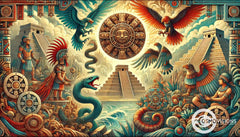Exploring the Rich Flavors of Aztec Food: A Dive into Aztec Cuisine and Mexican Culinary Heritage
Posted by Massimiliano Geraci

Are you curious about the rich tastes and traditions of Aztec cuisine? Maybe you’re looking for ways to connect with Mexico’s deep culinary roots. The flavors of Aztec food offer a window into a world where every meal tells a story of culture, community, and innovation.
Central to this ancient diet was maize, transformed into tortillas, tamales, and porridges that nourished an empire. Other popular and iconic Aztec foods included casseroles and sauces, made with local ingredients. Staple foods like beans, squash, nopales, and tomatoes were also essential, providing a diverse and nutritious diet.
This article will guide you through the fascinating world of Aztec meals—from their daily bread to grand feasts. You’ll learn about the key ingredients they relied on and how these foods still shape Mexican cuisine today.
And if you’re eager to discover more than just recipes, we’ll delve into the rituals that made eating a sacred act among the Aztecs. Ready for an adventure on your plate?
Daily Meals in Aztec Cuisine
Moving from a broad overview, we delve into the heart of daily life with Aztec cuisine. The Aztecs usually had two meals a day. Workers might have three to keep their strength up. These simple yet nutritious meals were key in sustaining the energy needed for their rigorous daily tasks. Food is our common ground, a universal experience. Families gathered for these meals, often featuring maize, beans, squash, and New World grains like amaranth and chia. This trio and salt and chili peppers symbolized the foundation of Aztec society’s diet. They also enjoyed tomatoes and avocados adding color and nutrients to their plates.
Meals were times for coming together, sharing stories, and planning for tomorrow.
Staple Foods: Maize, Beans, and Vegetables
Corn, also known as maize, ruled as the queen of Aztec cuisine. This golden grain found its way into everything from flatbreads to stews. Aztecs ground it into flour for making tortillas and soaked it for a simple yet nutritious gruel called ātōlli. At banquets, women would likely drink pozolli, a maize gruel made from finely ground maize.
This process, called nixtamalization, turned plain corn into a powerhouse of nourishment. It made the maize easier to work with and unlocked vital nutrients.
Beans were the perfect partner for maize, offering protein and variety to the Aztec diet. They often mixed these legumes with squashes and amaranths, creating dishes rich in flavor and health benefits.
Vegetables were not just add-ons but main characters in their meals. Vegetables brought color and life to every plate, from leafy greens harvested near lakes to spicy peppers that fired up their dishes.
The combination of these staples laid a foundation that fed an empire stretching across Mesoamerica.

The Role of Meat and Fish in Aztec Diet
Aztecs ate more than maize and vegetables. They also enjoyed meat from turkeys, dogs, and wild animals like deer. Lakes and rivers were full of fish, making them a key part of the Aztec diet.
Various members of Aztec society, including priests, commoners, and rulers, engaged in fasting as a religious and ceremonial practice.
People caught salamanders and frogs to eat as well. This shows how diversified their food sources were.
Hunting brought in animals such as rabbits for meals, while farming efforts domesticated turkeys for regular consumption. Fishermen used nets to catch various types of fish in nearby waters.
This variety ensured that the Aztec community had enough protein alongside their beans and squash staple foods. Adding insects like grasshoppers provided extra nutrients, showcasing the adaptability and resourcefulness of Aztec cooking methods.
Use of Spices and Flavorings
Spices and flavors added life to Aztec food. They used chili peppers, culantro, and oregano from Mexico to make dishes sing. Other ingredients like garlic, onions, and vanilla turned simple meals into feasts for the senses.
Red and green tomatoes mixed with chili were often used in sauces or as filling for tamales, adding vibrant flavors to their dishes.
Achiote painted foods red, while epazote brought a bold taste. These were not just for eating; they carried deep spiritual meanings too.
Every spice had its place in the kitchen or by the fire where Aztecs cooked. They valued moderation but knew how to celebrate with flavors. From savory meats seasoned with hoja santa to sweet drinks flavored with allspice, their cuisine was a rich tapestry of taste crafted from the earth’s bounty – connecting them deeply with nature and their gods.

Traditional Aztec Drinks: From Ātōle to Cacao
Moving from the rich spices and flavors of their food, the Aztecs also enjoyed a wide range of drinks. These were not just simple beverages but held great importance in their culture.
Ātōle, a thick drink made from maize flour, was more than just a drink; it was a vital part of their daily calorie intake. This maize gruel kept many full and energized throughout the day.
The elite had a special taste for cacao-based drinks. Cacao was rare and valuable, so much so that it was even used as money. Imagine drinking something as precious as gold! Their chocolate drink, cacahuatl, wasn't sweet like today's chocolate but bitter and strong, often mixed with spices to add flavor.
In addition to these, pulque—made from fermented sap—was common among all social classes as an alcoholic beverage. People also crafted other alcoholic drinks using honey, pineapple juice, or cactus fruit.
Each sip tells us about the Aztecs' deep connection with nature and innovative use of available resources to enhance their daily lives.
Supplementary Insights on Aztec Food
Discover how Aztec chefs used simple tools and clever techniques to create meals full of flavor. Learn about the role of steam in cooking, how they made their maize dough soft, and what feasts looked like in Tenochtitlan. Food preparation and consumption were deeply embedded in Aztec society's cultural and spiritual practices, reflecting their values and beliefs.
Explore with us for more secrets from the past!
Food Preparation Techniques
Exploring the art of Aztec food reveals deep connections to culture and spirituality. The Aztecs crafted meals with techniques that enriched both body and soul.
1. They boiled or steamed most dishes in clay pots known as xoctli. These containers held ingredients together, mingling flavors while preserving nutrients.
2. Women took charge in the kitchen, weaving their wisdom into every recipe. Their role was crucial, blending culinary skills with caretaking duties.
3. Nixtamalization was a breakthrough in Aztec cooking, turning maize into a powerhouse of nutrition. This process involved soaking corn in an alkaline solution, making it easier to grind and enhancing its health benefits.
4. Sweet potatoes, along with other vegetables like chili peppers, tomatoes, and squash, were commonly used in Aztec cooking.
5. Bernardino de Sahagún documented this method, highlighting its importance. His records show how ancient wisdom still influences modern cuisine.
6. The preparation of chocolate drinks for Aztec leaders showcased the luxury in their diet. Made from ground cacao beans, these beverages symbolized wealth and power.
Aztec cooks also used simple tools like grinding stones for maize dough, showing their ingenuity with limited resources. Next, we will explore the kitchen tools that shaped Aztec cuisine.
Kitchen Tools of the Aztecs
The Aztecs used special tools to make their food. These tools helped them grind, cook, and prepare delicious meals.
1. Manos and metates were stones used for grinding maize. People used a mano as a hand-held grinder against the flat surface of a metate.
2. Molcajetes, made from volcanic rock, mashed spices into paste for sauces.
3. Comals, simple clay or stone griddles, cooked tortillas and other foods over fire.
4. Wooden spoons stirred pots of beans and stews slowly simmering over flames.
5. Stone knives cut vegetables and meat with precision. These knives were sharp enough to slice through ingredients easily.
6. Woven baskets carried fruits, vegetables, and grains from markets to homes.
7. Clay pots held water, chocolate drinks, and even soups during feasting.
8. Gourds served as cups for drinking the popular frothy cocoa drinks or water among the Aztec people.
Each tool played a vital role in the daily meal preparations of the Aztec kitchen.
Feasting and Celebrations
Moving from the array of kitchen gadgets the Aztecs used, we enter their world of festivities and communal gatherings. These events were more than just eating together; they served as moments to honor deities and strengthen community bonds.
Feasts became elaborate ceremonies, with offerings to the gods. Special manners marked these occasions, showing deep respect for spiritual traditions.
Key celebrations, like the Tlacaxipehualiztli, melded intense rituals with communal dining experiences. During such times, not only did people share in specially prepared stews but these dishes contained sacrificed meat, linking them directly to religious beliefs and practices.
Wedding feasts brought guests together over tamales and chocolate while saying goodbye to loved ones involved sharing pulque and a variety of foods at funerary feasts. Each event wove together the physical and spiritual, using food as a bridge between worlds.

The Influence of Aztec Cuisine on Modern Mexican Culinary Heritage
Aztec cuisine has woven a rich tapestry in the flavors of modern Mexican food. The ancient methods, like nixtamalization—a way to prepare maize that unlocks its nutrients—still stand at the heart of dishes today.
Traditional foods like maize, beans, squash, chilis, nopales, and tomatoes have been prominent in the Mexican diet, historically and in present-day cuisine.
Tamales, a beloved street food, echo the Aztecs’ skilled use of corn and spices. This connection bridges centuries, showing how traditional recipes have endured the test of time. The past is alive in every bite we take. Mexican culinary heritage owes much to those ancient cooks who made feasts from maize, beans, and chilies. These staples form the backbone of today’s diet in Mexico. Chocolate drinks, once reserved for Aztec nobility, now delight people worldwide.
Thus, every sip and morsel carries whispers of an age-old culture that mastered the artistry of sustenance with what nature offered them.
Conclusion
Exploring Aztec cuisine opens doors to a vibrant culinary history. Corn, beans, and chilies fed ancient hearts and fueled mighty empires. Boiling in clay pots mingled flavors, and traditions formed.
Today, these ancient practices enrich Mexico's food landscape. The journey from past to plate continues to inspire and unite cultures.
FAQs
1. What did people eat in the Aztec empire?
In the Aztec empire, folks enjoyed a diet rich with maize, beans, and squash. They also savored wild game like deer and iguana. Noble members had access to exotic foods such as chocolate, made from fermented maize.
2. How important was maize in Aztec food?
Maize wasn't just a plant for the Aztecs; it was the heart of their diet... Soaked and cooked in an alkaline solution, grinding into flour for tortillas or tamales became easier, making it a staple on every table.
3. Did the Aztecs have any unique drinks?
Yes! The most popular drink among them was a frothy hot chocolate... Prepared by boiling cocoa with water and adding spices, this beverage was more than just a treat; it symbolized luxury and social status.
4. Were there any special cooking methods used by the Aztecs?
Indeed! The ancient chefs of Central Mexico were masters at drying or roasting their meats and vegetables... They even had thirty styles of dishes made according to specific traditions that kept meals exciting.
5. Can we still make authentic Aztec recipes today?
Absolutely! Many recipes have survived through time... Foods like nopal (cactus) salads or tamales can be prepared using ingredients available today for anyone wanting a taste of true history.
6. How did fasting fit into Aztec culture?
Fasting played a significant role in showing devotion among society's members. It wasn't about skipping meals but embracing simplicity to honor their gods at significant times throughout the year.






















